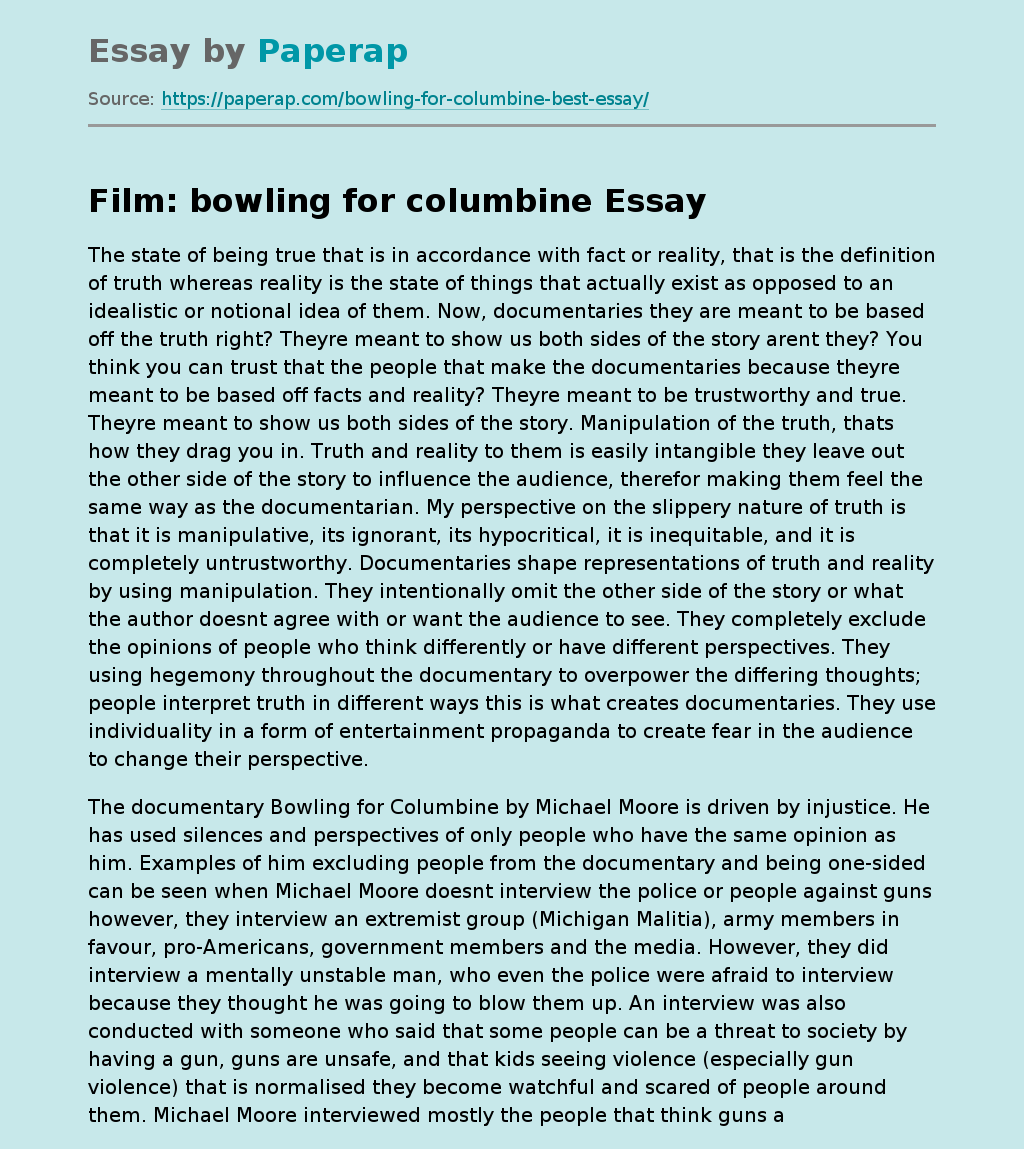Film: bowling for columbine
The state of being true that is in accordance with fact or reality, that is the definition of truth whereas reality is the state of things that actually exist as opposed to an idealistic or notional idea of them. Now, documentaries they are meant to be based off the truth right? Theyre meant to show us both sides of the story arent they? You think you can trust that the people that make the documentaries because theyre meant to be based off facts and reality? Theyre meant to be trustworthy and true.
Theyre meant to show us both sides of the story. Manipulation of the truth, thats how they drag you in. Truth and reality to them is easily intangible they leave out the other side of the story to influence the audience, therefor making them feel the same way as the documentarian. My perspective on the slippery nature of truth is that it is manipulative, its ignorant, its hypocritical, it is inequitable, and it is completely untrustworthy.
Documentaries shape representations of truth and reality by using manipulation. They intentionally omit the other side of the story or what the author doesnt agree with or want the audience to see. They completely exclude the opinions of people who think differently or have different perspectives. They using hegemony throughout the documentary to overpower the differing thoughts; people interpret truth in different ways this is what creates documentaries. They use individuality in a form of entertainment propaganda to create fear in the audience to change their perspective.
The documentary Bowling for Columbine by Michael Moore is driven by injustice. He has used silences and perspectives of only people who have the same opinion as him. Examples of him excluding people from the documentary and being one-sided can be seen when Michael Moore doesnt interview the police or people against guns however, they interview an extremist group (Michigan Malitia), army members in favour, pro-Americans, government members and the media. However, they did interview a mentally unstable man, who even the police were afraid to interview because they thought he was going to blow them up. An interview was also conducted with someone who said that some people can be a threat to society by having a gun, guns are unsafe, and that kids seeing violence (especially gun violence) that is normalised they become watchful and scared of people around them. Michael Moore interviewed mostly the people that think guns are an American identity and need them to protect themselves. By showing mostly the perspectives of people who think they need guns and people who support guns, Michael Moore has made a cultural assumption that America has a culture of fear relating to gun violence. This can be related back to the slippery nature of truth, the truth shown is inconsistent as there are only arguments for guns shown. Michael Moore and the audience perception of truth can alter and can be seen as the percentage of facts, such as the school shooting compared to the percentage of fiction, which are represented by the opinions of people who were interviewed throughout the documentary.
The structure of this documentary is at the start it shows how easy guns are attained, then shows the Columbine High School shooting, then goes on to look at the causes and who is to blame. Michael Moore used flashbacks throughout the documentary to show why gun violence is an issue, he shows how the shooting played out as well as the parents of the Columbine kids calling. The use of juxtaposition can be seen when he shows people getting shot at compared to someone saying this is a great place to bring kids up, these two examples contradict each other and show that he is manipulating the truth. The manipulation of truth in Bowling for Columbine can be seen when he uses cinematic techniques. The most affective cinematic technique that Moore uses is editing, Charlton Hestons speech where he proudly proclaims from my cold dead hands right after various audio and video recordings of the Columbine Massacre are shown which implies that he said these things shortly after the shooting.
The techniques that is used include, happy and uplifting music when showing guns being fired, slow sad music as parents call police to see what happened at Columbine High School, the comparison between different countries, archival footage, as well as editing Charlton from the NRA made to look as if he doesnt care. Michael Moore is only telling us what he wants us to know, he has edited the video of Charlton (NRA) to look as if he wasnt bothered by the Columbine shooting by saying from my cold dead hands as he held up a rifle, however it is clear that he did not say this after the shooting, the footage was taken from a prior meeting as you can see by the colour of his tie, he was wearing a blue tie as he expressed his sorrows for the people who were involved in the Columbine shooting whereas in the video where he holds up the gun he is wearing a red tie, this is a complete manipulation of the truth.
In conclusion, Bowling for Columbine by Michael Moore is completely bias and can be seen through his silences and perspectives as well as the techniques and structure of the documentary. The slippery nature of truth. It can be so easily manipulated to show us only what the authors want us to see or know, documentaries can be completely one-sided by silencing the people who have different opinions. The audience is positioned to view a documentary from a particular perspective as they dont show everything.
Film: bowling for columbine. (2019, Dec 19). Retrieved from https://paperap.com/bowling-for-columbine-best-essay/

